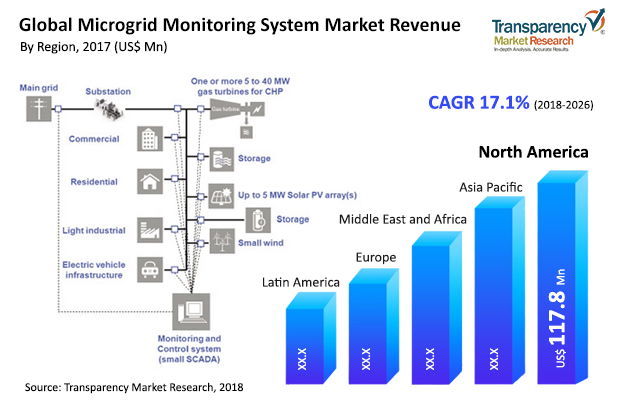The global microgrid monitoring systems market is projected at a staggering CAGR of 17% between 2018 to 2026, finds an upcoming Transparency Market Research (TMR). The market was valued at US$ 300mn in 2017 and it is projected to reach an estimated value of US$1.3bn by the end of 2026.
In terms of product, hardware segment is expected to dominate the global microgrid monitoring systems market and lead to expansion during the projected period. The increasing demand for effective monitoring during real time functioning in the microgrid is expected to be the factor behind the growth of hardware segment.
More Trending Reports by Transparency Market Research –
Additionally, a microgrid enhances the proper distribution of power supply, conserves energy, and it is a reliable source of energy. These features help in the growth potential of the global microgrid monitoring systems market. 
Smart Sensors Strengthens Microgrid Monitoring Systems Market
Smart sensors and new technologies make them a viable option to ensure control and energy management to ensure distributed and economical operations of microgrids, leading to the surge in the global microgrid monitoring systems market.
Request PDF Brochure –
https://www.transparencymarketresearch.com/sample/sample.php?flag=B&rep_id=24434
Equipping microgrids with sensors and connected devices are some of the smart way towards smart microgrids, pushing the global microgrid monitoring systems market to expand in the upcoming years.
REQUEST FOR COVID19 IMPACT ANALYSIS –
https://www.transparencymarketresearch.com/sample/sample.php?flag=covid19&rep_id=24434
The integration of IoT and distributed control system helps in data acquisition, data uploading, and device control, thus, pushing the surge in the microdgrid monitoring systems market in the near future. On the basis of application, it is campus segment that holds a major share in the market due to availability of technology to mitigate, reduce risk and improve efficiency.
Further, the deployment of sensors and internet of things help in accessing real time data for ongoing and forthcoming microgrid projects, nudging the growth of the global micrtogrid monitoring systems market. Additionally, increase in dependability of renewable source of energy is expected to drive the market towards expansion. Research and development and further innovations are leading to the expansion of the global microgrid monitoring systems market.
Alternatively, there are few factors that may hinder the growth of the global microgrid monitoring systems market. Economic recession and high cost of installation may dampen the growth.
Nonetheless, increasing technological advancement and research and development for viable renewable sources of energy generation is expected to propel the market growth in upcoming years.
Asia Pacific to Boost Growth in Global Microgrid Systems Market
The Asia Pacific is expected to dominate the global microgrid monitoring systems market in the upcoming years. The growth is attributable to rising demand for electricity generation form other renewable sources, increasing number of microgrid installation projects, rapid urbanization, and industrialization. In Asia Pacific, China is expected to emerge as a lucrative economy in the global microgrid monitoring systems during the forecast period.
Alternatively, North America is also foretold to surge in the global microgrid monitoring systems market. The growth in this region can be due to presence of advanced technologies that can be integrated in microgrids.
Some of the key players operating in the global microgrid monitoring systems market are Eaton Corporation, Siemens AG, Exelon Corporation, S & C Electric Company, Caterpillar Inc., General Electric, ABB Ltd, and Enercom GmbH. The global microgrid monitoring
Systems market faces cut throat competition due to the presence of these prominent players. Each company is adopting various strategies to outperform others and penetrate in to the global market.
This review is based on the findings of a TMR report titled, “Microgrid Monitoring Systems Market (Application – Military, Campus, Community, Island, Remote; Product – Hardware, Software) – Global Industry Analysis, Size, Share, Growth, Trends, and Forecast 2018 – 2026.”
